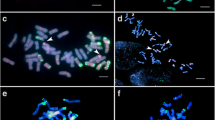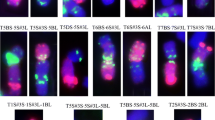Abstract
Specific chromosomes of certain Aegilops species introduced into wheat genome background may often facilitate chromosome breakage and refusion, and finally result in a variety of chromosome restructuring. Such a phenomenon is commonly called gametocidal effect of the chromosomes. The chromosome 2C of Ae. cylindrica is one of such chromosomes. In the present study, scab resistant wheat-L. racemosus addition lines involving chromosomes Lr.2 and Lr.7 were crossed to wheat-Ae. cylindrica disomic addition line Add2C. Then F1 hybrids were subsequently backcrossed with wheat cv “Chinese Spring”. BC1 plants with chromosome structural aberration were identified by C-banding. In the self-pollinated progenies of these plants, three translocation lines were developed and characterized by mitotic and meiotic analysis combined with C-banding and fluorescent in situ hybridization (FISH) using biotin-labeled genomic DNA of L. racemosus as probe. Some other putative translocation lines to be further characterized were also found. The practicability and efficiency of the translocation between wheat and alien chromosomes induced by gametocidal chromosomes, as well as the potential use of the developed alien translocation lines were also discussed.
Similar content being viewed by others
References
Maan, S. S., Exclusive preferential transmission of an alien chromosome in common wheat, Crop Sci., 1975, 15: 287–292.
Endo, T. R., Sterility of common wheat with Aegilops triuncialis cytoplasm, J. Heredity, 1975, 66: 13–18.
Endo, T. R., Induction of chromosomal structural changes by a chromosome of Aegilops cylindrica in common wheat, Journal of Heredity, 1988, 79: 366–370.
Kibirige-Sebunya, I., Knott, D. R., Transfer of stem rust resistance to wheat from an Agropyron chromosome having a gametocidal effect, Can. J. Genet. Cytol., 1983, 215–221.
Marias, G. F., Preferential transmission in bread wheat of a chromosome segment derived from Thinopyrum distichum (Thumb.), Plant Breeding, 1990, 104: 12–19.
Tsujimoto, H., Tsunewaki, K., Hybrid dysgenesis in common wheat caused by gametocidal genes, Jpn. J. Genet., 1985, 60: 565–578.
Endo, T. R., The deletion stocks of common wheat, J. Herdeitg., 1996, 87: 295–307.
Gill, B. S., Molecular cytogenetic explorations into the genome of wheat, in Proc. 9th International Wheat Genetics Symposium, Saskatoon, Canada (ed. Slinkard, A. E.), Canada: University Extension Press, 1998, vol. 1, 29–32.
Endo, T. R., Structural changes of rye chromosome IR induced by gametocidal chromosome, Jap. J. Genet., 1994, 69: 11–19.
Shi, F., Endo, T. R., Genetic induction of structural changes in barley chromosomes added to common wheat by a gametocidal chromosome derived from Aegilops cylindrica, Genes Genet. Syst., 1999, 74: 49–54.
Chen, P. D., Wang, Z. D., Wang, S. L. et al., Transfer of useful germplasm from Leymus racemosus to common wheat III. Development of addition liner with scab resistance, Acta Genetica Sinica, 1995, 22: 206–210.
Liu, W. X., Chen, P. D., Liu, D. J., Studies of the development of Triticum aestivum-Leymus racemosus translocation lines by pollen irradiation, Acta Genetica Sinica, 2000, 27(1): 40–49.
Liu, W. X., Chen, P. D., Liu, D. J., Development of Triticum aestivum-Leymus racemosus translocation lines by irradiating adult plants at meiosis, Acta Botanica Sinica, 1999, 41(5): 463–467.
Gill, B. S., Friebe, B., Endo, T. R., Standard karyotype and nomenclature system for description of chromosome bands and structural aberrations in wheat, Genome, 1991, 34: 830–834.
Chen, P. D., Zhou, B., Qi, L. L. et al., Identification of wheat-Haynaldia villosa amphiploid, addition, substitution and translocation lines by in situ hybridization using biotin-labelled genomic DNA as a probe, Acta Genetica Sinica, 1995, 22(5): 380–386.
Friebe, B., Jiang, J., Raupp, W. J. et al., Characterization of wheat-alien translocations conferring resistance to disease and pests: Current status, Ephytica, 1996, 91: 59–87.
Xu, Y. G., Fan, Z. D., Evaluation and differentiation of patogenicity of Fusarium graminearum on wheat cultivars, Acta Phytopatology Sinica, 1982, 12(4): 53–57.
Author information
Authors and Affiliations
Corresponding author
Rights and permissions
About this article
Cite this article
Yuan, J., Chen, P. & Liu, D. Development of Triticum aestivum-Leymus racemosus translocation lines using gametocidal chromosomes. Sci. China Ser. C.-Life Sci. 46, 522–530 (2003). https://doi.org/10.1360/01yc0298
Received:
Issue Date:
DOI: https://doi.org/10.1360/01yc0298




